'I was shocked': First trooper to arrive at Webbers Falls bridge disaster recalls scene
At the Webbers Falls Memorial Park off River Drive is a memorial park with the names of 14 people who died when a barge struck the Interstate 40 Arkansas River 20 years ago.
A monument shows a young girl with arms stretched upward as she releases a dove. Her left toe pushes off a beam of a bridge. A clock on the sculpture says 7:48 a.m. The names of those who died are on a canoe-shaped dark base. The United States and Oklahoma flags fly in a strong wind that blows off the river, about 200 yards from bank to bank.
Oklahoma Highway Patrol trooper Rodney Copeland of Sallisaw worked in marine enforcement in 2002. He lived nearby in Sallisaw.
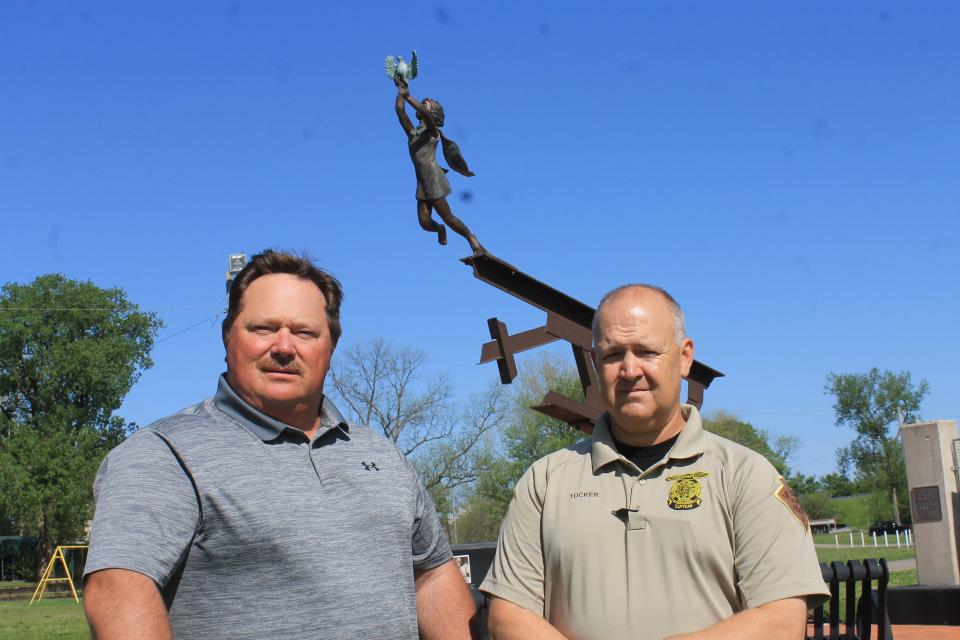
He was assigned to the marine enforcement division of the Oklahoma Lake Patrol when he responded to a Memorial Day duty like none he had experienced before.
Read this: How this Oklahoma reporter navigated tragedy and uncertainty to cover I-40 bridge disaster
Gone but not forgotten: Former mayor to host memorial in honor of Webbers Falls bridge tragedy
He'd been a trooper for five years and had worked his share of drownings, fatal boating accidents and other incidents on the state's lakes and rivers. Usually, he was busiest in the summer months, and of course, on holiday weekends such as Memorial Day.
He was asleep shortly before 8 a.m. on that Sunday, May 26, the day before Memorial Day, when the telephone rang. He would be the first OHP trooper to see the horror at the bridge and in the water.
It was only nine months after the terrorist attacks in New York City and at the Pentagon on Sept. 11, 2001, and some of the early reports he heard from dispatchers over scanner traffic aired some confusion as to which bridge had been hit, the I-40 bridge or the U.S. 64 bridge, both over the Arkansas River at Webbers Falls and about one mile apart. The thought rushed through his mind that maybe two bridges had been taken out and it was a terrorist attack.
"You have to remember, this was just seven to eight months after the 9/11 so there were a lot of things going through my mind when responding to this incident because you have to think, 'Could this have been a terroristic situation? What are we dealing with when we get there?' And so, as a first responder, those are the things that are running through your head when you are responding to an incident, especially since something like 9/11 was still fresh."
The traffic was backing up for miles on I-40, there was no confusion as to which bridge was down when he got out of the vehicle. Dispatchers reported a section of the bridge was gone, but not as much as he found – nearly 600 feet was missing.
The Arkansas River is as wide at Webbers Falls as any place in Oklahoma, a state where river traffic ends for barges. The water was swift and rain-swollen from overnight showers. A bass tournament had been underway, and when Copeland got in the boat, the fishermen were rescuing victims.
A patrol boat was waiting at a dock on the Illinois River, where it feeds into the Arkansas River, to take Copeland to the barge that struck the bridge.
"Once we got the boat on the water and we actually unloaded the boat in the Illinois River above stream of the Arkansas River and turned left, I was shocked to see what in my mind was 50 to 60 feet, according to dispatch, that was gone and it was more like 400 to 500 feet of the bridge," Copeland said. "It's breathtaking. It's not what you're expecting to see, but we had a job to do and my job was to get onboard that tugboat and see what our situation was."
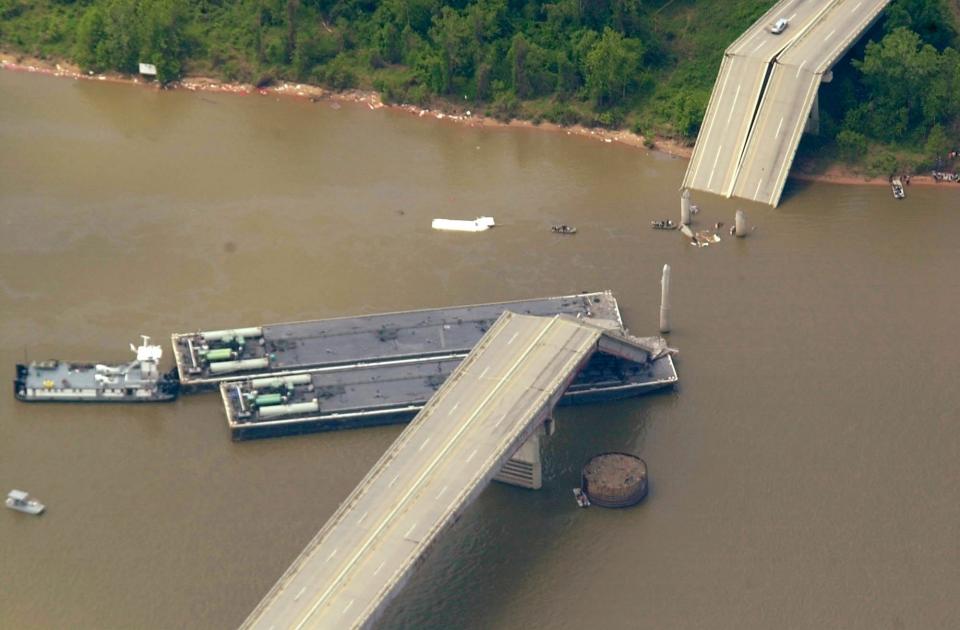
Copeland rode in a patrol vehicle with Capt. Damon Tucker across the flatlands a few miles north of I-40. Tucker had also responded to the bridge 20 years ago and said he recalls during the investigation he interviewed a man who had escaped a submerged vehicle and swam to the surface.
Copeland had joined the Oklahoma Lake Patrol in 1997 and worked in marine enforcement for 25 years.
"Water was kind of my deal so that is where I stayed," Copeland said. The patrol vehicle approached the rebuilt bridge.
Mostly, the career had been about water safety, checking people on their personal boats.
"In the summer months we're on the water, we're making sure that everybody is operating the way they should be and not endangering lives," he said.
A total of 14 people died and 11 people were injured. Bodies would be recovered for four days.
On the barge, employees were trying to rescue survivors of the vehicles that plunged off the opening in the bridge above them. James Bilyeu of Conway was a truck driver who survived a plunge off the bridge and into the river.
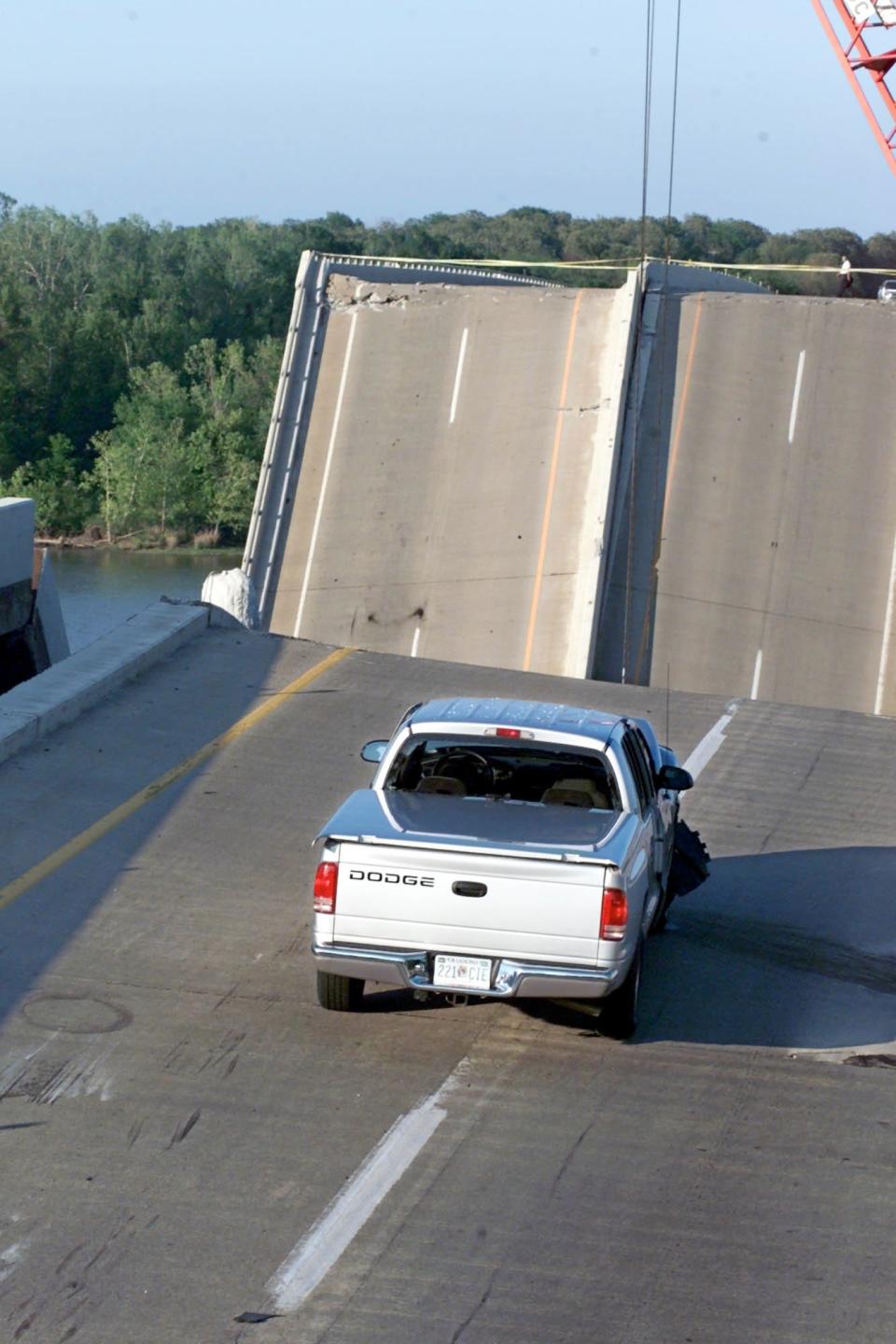
Had a flare gun not been fired by a fisherman in a bass tournament, flagging down a truck driver who stopped in time, more vehicles might have gone over and down into the currents. The fisherman who fired the flare from a boat is credited with saving lives that day.
"Of course, there were a lot of employees that were on the boat. They had been doing rescues," Copeland said.
There were parts of vehicles sticking out of the water. Debris covered the surface. Concrete and steel rebar jutted out of the mighty river mess and tragic loss.
A portion of the bridge had landed on top of one of the barges pulled by the tugboat. The operator, who had passed out from a medical condition, had regained consciousness when the patrol boat approached them.
"The tugboat was still under power at the time that I arrived because he wasn't certain at that moment that if he let off the throttle that he wasn't going to rip the rest of the bridge down," Copeland said.
Troopers had shut down traffic in both directions. The normal hum of thousands of vehicles a day over a major artery of interstate traffic was shut down. But there was anything but peace and calm in the water.
Subscribe!>
"It was an overwhelming experience. But I knew I had to get on that tugboat and figure out what the situation was and start the investigation from there," Copeland said.
He said Trooper Walters tied next to the tugboat.
"Trooper Walters had met me when I was putting my boat on the water in the Illinois River. Myself and Trooper Walters tied up to the tugboat. And of course, we approached with caution and can see who we were dealing with and what we were dealing with at that point," Copeland said. "I can remember all the tugboat employees being exhausted. They were able to put a boat on the water and start rescuing people."
Bass fishermen were also heroes from the interrupted tournament that day.
"There was a bass tournament that was going on on the river that same morning and a lot of the guys who were involved in that tournament played crucial roles in rescuing people and letting people know what equipment we needed and who we needed to respond," Copeland said.
Copeland and Walters got aboard the tugboat.
Joe Dedmon, captain of the towboat Robert Y. Love, was transporting barges on the Arkansas River. While traversing the Robert S. Kerr Reservoir, Dedmon experienced a medical condition reported as a syncope and lost control of the tow, the final investigation determined.
What happened was not known when Copeland and Walters questioned Dedmon.
"We made our way to the wheelhouse where the operator of the tugboat was. Of course, we interviewed him quickly and explained to him what we were doing and how we were going to handle the situation and, of course, let him know we would have to take him off the boat," Copeland said.
Related: Here are the names of those who died in 2002 bridge disaster in Webbers Falls
'Very surreal, tragic time': ODOT spokeswoman remembers 2002 Webbers Falls bridge collapse
"He was cognitive, he knew, and very somber and very aware of the situation and how traumatic everything was," Copeland said.
The crew members were separated and each made separate reports of what vehicles they saw come off the bridge and land in the water.
"We didn't know how many vehicles we had in the water," Copeland said.
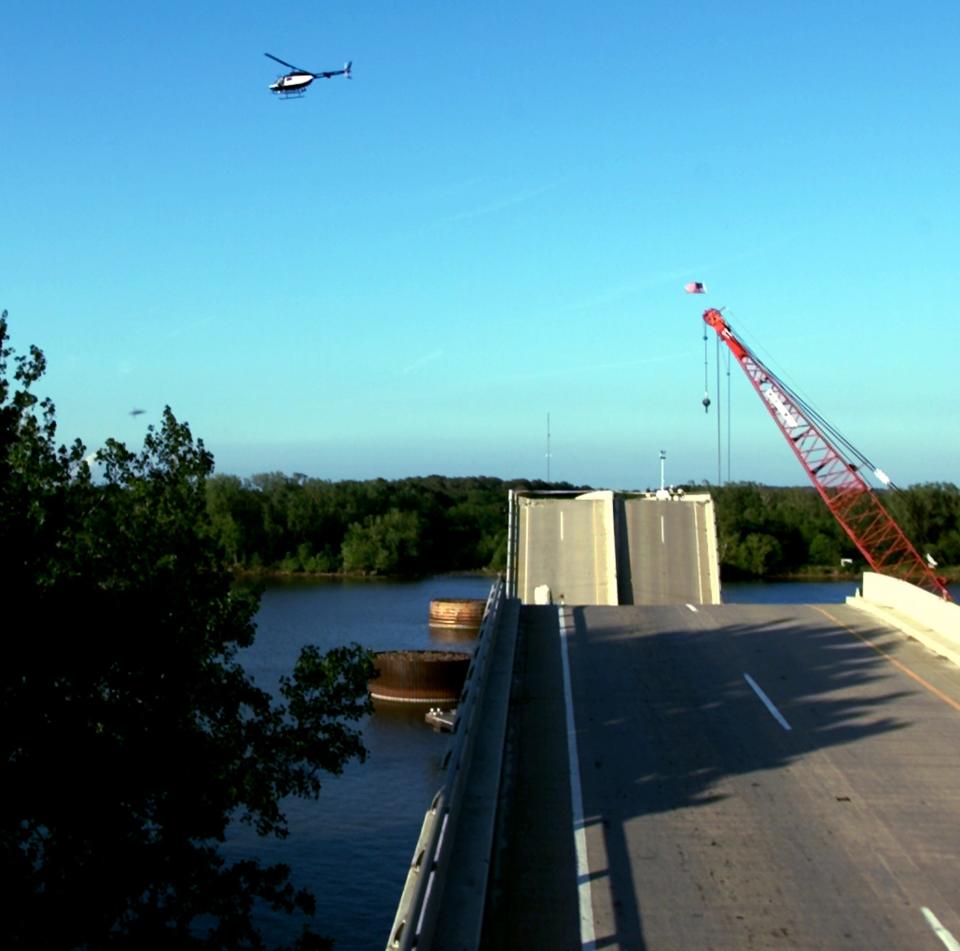
Each crew member reported what they remembered seeing. Divers were called and the search and rescue turned to recovery efforts.
Capt. Tucker drove without speaking across the bridge on a recent day, approaching from the same direction the Johnson family had gone from Lavaca, Arkansas on the day the family lost their lives headed to the Tulsa Zoo. Copeland stopped talking and looked across the river on a sunny day, the water high from heavy recent rains.
Copeland said the dive team members were new at the time, and many of them did not have experience recovering bodies.
"They did a really good job for the situation that we were in to not have a whole lot of experience at the time. Now a lot of those guys had been diving for a long time but they were not on the dive team for very long. The dive team and the marine enforcement guys were all that did any recoveries."
The U.S. Army Corps of Engineers team used a crane to help lift vehicles. Local volunteer fire departments brought equipment and tools, including the Jaws of Life to pry the vehicles' doors open.
"I don't know how many days in a row we were on the scene, but I do know that on day four one of the troopers recovered the toddler (Shae Johnson, 3). So as far as recoveries it was four days straight of body recoveries. But we remained on the scene for weeks longer than that and I don't know how many days straight it was that we were on the scene."
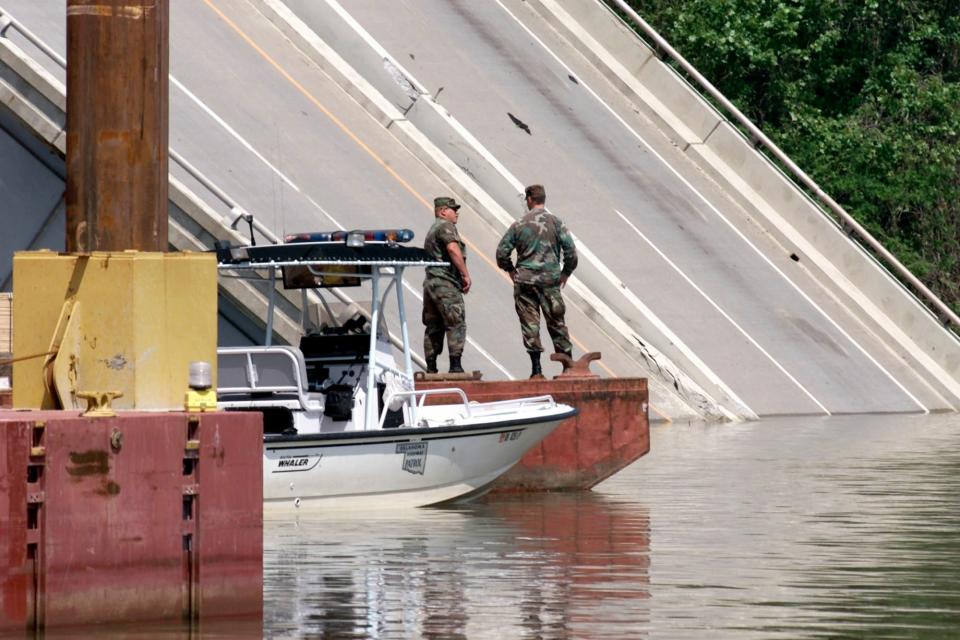
Capt. Tucker parked at the Memorial Park statue of the toddler. Photographs of her family sit on the monument's base. To the east-southeast, the river turns toward the bridge. Two large homes rest on a bluff overlooking the brown-colored waters. The annual memorial ceremony is planned for Memorial Day.
More on the Webbers Falls bridge collapse
Victims
Reporter
ODOT
Memorial
This article originally appeared on Fort Smith Times Record: Oklahoma Highway Patrol trooper recalls Webbers Falls bridge disaster

